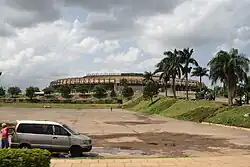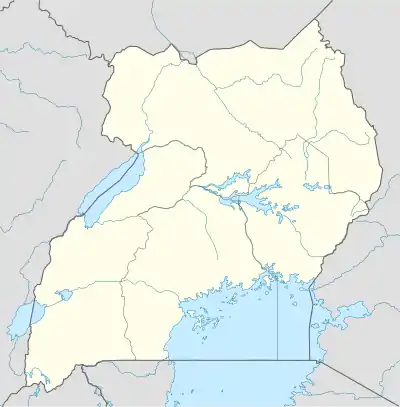Mandela National Stadium
The Mandela National Stadium is a multi-purpose stadium in Uganda. It is named after the South African then-President and anti-apartheid icon, Nelson Mandela.[3] The stadium's record attendance of 50,000 was set in 2004, in a football match between the national football teams of Uganda and South Africa.[4]
Namboole Stadium | |
 | |
 Mandela National Stadium Location within Uganda | |
| Full name | Mandela National Stadium |
|---|---|
| Former names | Namboole National Stadium (1997–2013) |
| Location | Bweyogerere Kira Municipality Central Region Uganda |
| Coordinates | 00°20′52″N 32°39′33″E[1] |
| Capacity | 45,202[2] |
| Record attendance | 50,000 (Uganda vs South Africa, 10 October 2004) |
| Surface | Grass |
| Construction | |
| Opened | 1997[2] |
| Renovated | 2010–11, 2022–23 |
| Construction cost | US$36 Million[2] |
| Main contractors | Chinese construction company |
| Tenants | |
| Uganda national football team SC Villa | |
| Website | |
| Homepage | |
Location
The stadium is located on Namboole Hill in Bweyogerere Ward, Kira Municipality, Wakiso District. The stadium is approximately 10 kilometres (6.2 mi), by road, east of the central business district of Kampala, Uganda's capital and largest city.[5]
Overview
Mandela National Stadium is mainly used for soccer matches, although other sports such as athletics are also practised. The stadium has a capacity of 45,202.[2] The stadium is home to the Uganda national football team, known as the Uganda Cranes.[6]
The stadium was built with a grant of US$36 million from the People's Republic of China (PRC). Originally it was called Namboole Stadium, getting its name from the hill on which it was built. It is now officially called Mandela National Stadium, named after the former South African president, Nelson Mandela. It was opened in 1997 with a concert by Lucky Dube, a reggae artist from South Africa.[2]
The stadium was refurbished in 2010–11, with a US$2.8 million grant from the PRC.[7]
A committee of the Ugandan parliament reported in 2015 that the stadium was on the verge of financial collapse, claiming that the stadium had suffered from more than a decade of "mismanagement and wanton abuse" and incurred losses totaling UGX:3.6 billion.[8] Running the stadium profitably in a private-public partnership arrangement remains a challenge.[9]
In 2020, the stadium was blacklisted from hosting football matches due to a substandard state.[10] The reconstruction works, taken by the UPDF Engineering Brigade, have started in 2022, including the installation of a permanent seats in the stadium, new dressing rooms, scoreboard, as well as refreshing the floodlights and the pitch.[10]
References
- Google (26 October 2016). "Location of Mandela National Stadium, Uganda" (Map). Google Maps. Google. Retrieved 26 October 2016.
- Stadiumdb.com (26 October 2016). "Nelson Mandela National Stadium (Namboole)". Stadiumdb.com. Retrieved 26 October 2016.
- Bakama, James (7 December 2013). "Ugandan sports will miss Mandela". New Vision. Kampala. Retrieved 26 October 2016.
- "Uganda national football team statistics and records: Attendances".
- Globefeed.com (26 October 2016). "Distance between Kampala Road, Kampala, Uganda and Mandela National Stadium, Kampala, Central Region, Uganda". Globefeed.com. Retrieved 26 October 2016.
- "Pictorial: The Historical Day At Namboole As Uganda Cranes Qualified For AFCON 2017 In Gabon". The Red Pepper Newspaper. Mukono. 5 September 2016. Retrieved 26 October 2016.
- Bakama, James (1 August 2010). "Mandela stadium facelift commences". New Vision. Kampala. Retrieved 26 October 2016.
- Mwesigwa, Alon (27 May 2015). "Mandela Stadium at the edge of collapse". The Observer (Uganda). Retrieved 26 October 2016.
- Igasira, Neville (1 December 2013). "The woes of running a multi-sports stadium". East African Business Week. Kampala. Retrieved 26 October 2016.
- "Namboole stadium to be ready by June – UPDF Engineering Brigade". The Independent. 21 January 2023. Retrieved 11 June 2023.